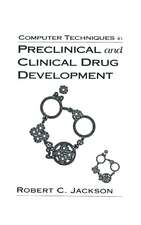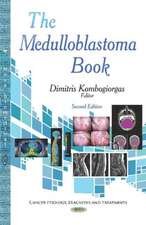Evolutionary Dynamics of Malignancy: The Genetic and Environmental Causes of Cancer
Autor Robert C. Jacksonen Limba Engleză Paperback – 26 iun 2024
Chapters of this book deal with the signalling pathways that control cell division, and changes in these pathways in cancer cells. Three cell cycle checkpoints that are often mutated in cancer are analysed in detail. A discussion of chronic myeloid leukaemia illustrates the role of reactive oxygen species in driving progression from a chronic to an acute condition. A single drug that suppresses reactive oxygen can prevent disease progression and turn an otherwise deadly disease into a condition that can be managed to enable many years of normal life. Another chapter discusses chronic myelomonocytic leukaemia, a disease that involves both genetic and epigenetic change. Tumour progression is discussed as a multi-stage process in which cancer stem cells evolve into genetically unstable, invasive, metastatic, drug-resistant growths. Each of these stages can act as targets for drugs or immunomodulators, but the future of cancer treatment lies in understanding tumour dynamics, and arresting malignancy at the earliest possible stage.
Evolutionary dynamics is a primarily mathematical technique, but the target readership will be tumour biologists, clinicians, and drug developers. Computational detail is provided in an online supplement, but the main text emphasises the implications of the dynamics for an understanding of tumour biology and does not require mathematical expertise.
| Toate formatele și edițiile | Preț | Express |
|---|---|---|
| Paperback (1) | 1035.07 lei 38-44 zile | |
| Springer International Publishing – 26 iun 2024 | 1035.07 lei 38-44 zile | |
| Hardback (1) | 1163.74 lei 6-8 săpt. | |
| Springer International Publishing – 25 iun 2023 | 1163.74 lei 6-8 săpt. |
Preț: 1035.07 lei
Preț vechi: 1089.54 lei
-5% Nou
Puncte Express: 1553
Preț estimativ în valută:
198.12€ • 215.28$ • 166.53£
198.12€ • 215.28$ • 166.53£
Carte tipărită la comandă
Livrare economică 17-23 aprilie
Preluare comenzi: 021 569.72.76
Specificații
ISBN-13: 9783031325755
ISBN-10: 3031325753
Ilustrații: XIV, 269 p. 96 illus., 58 illus. in color.
Dimensiuni: 155 x 235 mm
Ediția:2023
Editura: Springer International Publishing
Colecția Springer
Locul publicării:Cham, Switzerland
ISBN-10: 3031325753
Ilustrații: XIV, 269 p. 96 illus., 58 illus. in color.
Dimensiuni: 155 x 235 mm
Ediția:2023
Editura: Springer International Publishing
Colecția Springer
Locul publicării:Cham, Switzerland
Cuprins
Chapter 1: Cancer as a Disease of Cell Proliferation.- Chapter 2: Genetic and Chromosomal Instability.- Chapter 3:Cancer as a Disease of Defective Cell Cycle Checkpoint Function.- Chapter 4: The DNA Damage Checkpoint.- Chapter 5:Dynamics of the Spindle Assembly Checkpoint.- Chapter 6: Cancer as a Disease of Complexity: The Dynamics of Drug Resistance.- Chapter 7: Chronic Myeloid Leukaemia: a One-Hit Malignancy.- Chapter 8: Chronic Myelomonocytic Leukaemia: a Three-Hit Malignancy.- Chapter 9: The Cancer Stem Cell and Tumour Progression.- Chapter 10: Evading the antitumour immune response.- Chapter 11: Implications of Evolutionary Dynamics for Cancer Treatment and Prevention.- Chapter 12: In science, all conclusions are provisional.
Notă biografică
Robert C. Jackson provides consulting services in pharmacodynamics and biomathematics. After academic positions at Yale, London, and Indiana Universities he worked in the pharmaceutical and biotechnology industries. Post-retirement volunteer positions have included Chairman of the Discovery Committee and Vice-Chair of the Clinical and Translational Research Committee for the charity, Cancer Research UK. He is author of three previous books and author or co-author of over 150 research papers which have received over 5,000 citations. Recent publications include work on evolutionary biology and on the evolutionary dynamics of leukaemias.
Textul de pe ultima copertă
Advances in cancer genomics are transforming our understanding of cancer, and have profound implications for its prevention, diagnosis, and treatment. Evolutionary dynamics suggests that as few as two mutations can cause transformation of normal cells into cancer stem cells. A process of Darwinian selection, involving a further three or more mutations, taking place over a period of years, can then result in progression to a life-threatening tumour. In many cases the immune response can recognise and eliminate the mutant cells, but most advanced tumours have mutations that activate immune checkpoints and enable the tumour to hide from the immune system. For the most hard-to-treat tumours, future progress will require molecular diagnostics to detect cancer-causing mutations in healthy subjects, and new drugs or vaccines that prevent the progression process.
Chapters of this book deal with the signalling pathways that control cell division, and changes in these pathways in cancer cells.Three cell cycle checkpoints that are often mutated in cancer are analysed in detail. A discussion of chronic myeloid leukaemia illustrates the role of reactive oxygen species in driving progression from a chronic to an acute condition. A single drug that suppresses reactive oxygen can prevent disease progression and turn an otherwise deadly disease into a condition that can be managed to enable many years of normal life. Another chapter discusses chronic myelomonocytic leukaemia, a disease that involves both genetic and epigenetic change. Tumour progression is discussed as a multi-stage process in which cancer stem cells evolve into genetically unstable, invasive, metastatic, drug-resistant growths. Each of these stages can act as targets for drugs or immunomodulators, but the future of cancer treatment lies in understanding tumour dynamics, and arresting malignancy at the earliest possible stage.
Evolutionary dynamics is a primarily mathematical technique, but the target readership will be tumour biologists, clinicians, and drug developers. Computational detail is provided in an online supplement, but the main text emphasises the implications of the dynamics for an understanding of tumour biology and does not require mathematical expertise.
Evolutionary dynamics is a primarily mathematical technique, but the target readership will be tumour biologists, clinicians, and drug developers. Computational detail is provided in an online supplement, but the main text emphasises the implications of the dynamics for an understanding of tumour biology and does not require mathematical expertise.
Caracteristici
Discusses changes in pathways that drive malignant transformation Chapters are enriched with computational models in an electronic supplement Targeted to tumour biologists, clinicians and drug developers



















